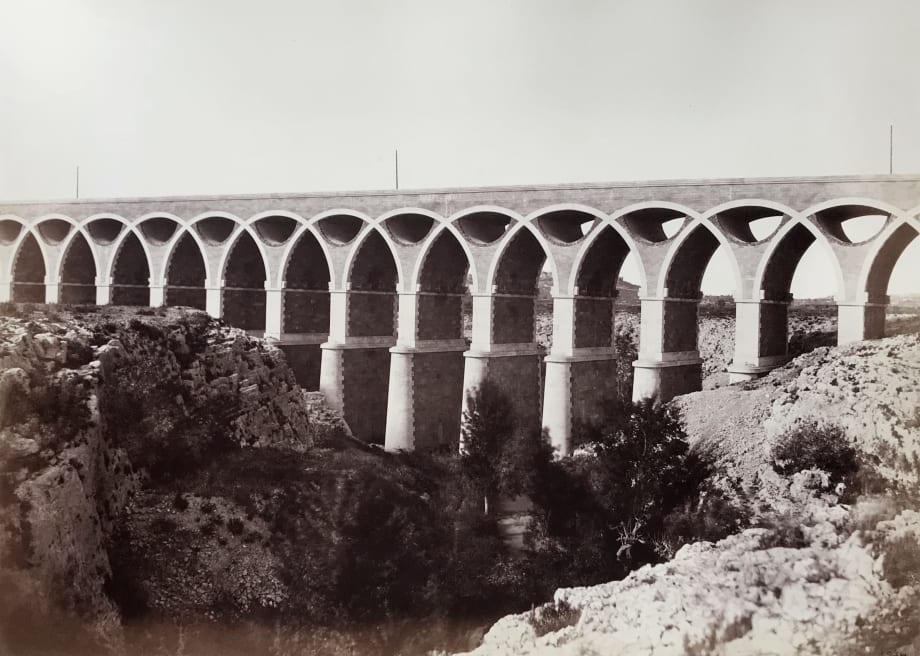Walls and Bridges. Edouard Baldus: A Bicentenary Exhibition
James Hyman is pleased to celebrate the bicentenary of the birth of Edouard Baldus, the greatest architectural photographer of the nineteenth century.
Coinciding with an exhibition of important 19th and 20th Century Vintage work at AIPAD, James Hyman will present a retrospective overview of Baldus's remarkable achievements. The works range from Baldus's earliest known photographs from c.1849 to his magnificent albums depicting the building of the new Louvre, as well as works that depict the construction of the French railways.
At the heart of the exhibition is a complete set of four albums documenting the building of the Louvre and Tuileries Palaces, one of the major architectural projects of the Second Empire. These four volumes, specially commissioned by Napoleon III, contain over five hundred salt prints by the artist, and are believed to be the finest set of albums to have come on the market.
Edouard Baldus produced some of the largest and grandest early photographs in existence and pioneered an aesthetic of modernity that continues to have a profound influence on photographers to this day. As Andre Jammes has written: 'Baldus's working methods were those of an Imperial dramatist. A master printer, his proofs were more richly achieved than any his contemporaries had ever seen[Baldus was] notorious for the unprecedented scale of his negatives.
By 1851, Baldus had invented his own refinement of the paper negative process. His method gave such clarity of detail and sharpness that contemporary photographers, such as Stephane Geoffray, marvelled at how Baldus had achieved this using paper negatives rather than glass plates:
'Who has not asked himself upon considering the admirable prints of Notre Dame, the Pantheon and many others by M. Baldus, if they were not obtained on glass! A total absence of grain, a strength and transparency of shadow, a brilliance of light - such are the qualities that recommend the beautiful prints of this skilled photographer. (1855)
In 1994 the Metropolitan Museum of Art, New York, staged a justly celebrated exhibition, curated and researched by Malcolm Daniel, which did more than any other event to establish the brilliance of Baldus. Nearly twenty years on, new discoveries are still being made - bodies of work that were previously unknown, biographical information that was unsuspected - and it is hoped that this presentation will convey to a new, as well as existing audience some of the aspects that continue to make the photographs of Edouard Baldus so fascinating, powerful and exhilarating.
James Hyman is pleased to celebrate the bicentenary of the birth of Edouard Baldus, the greatest architectural photographer of the nineteenth century.
Coinciding with an exhibition of important 19th and 20th Century Vintage work at AIPAD, James Hyman will present a retrospective overview of Baldus's remarkable achievements. The works range from Baldus's earliest known photographs from c.1849 to his magnificent albums depicting the building of the new Louvre, as well as works that depict the construction of the French railways.
At the heart of the exhibition is a complete set of four albums documenting the building of the Louvre and Tuileries Palaces, one of the major architectural projects of the Second Empire. These four volumes, specially commissioned by Napoleon III, contain over five hundred salt prints by the artist, and are believed to be the finest set of albums to have come on the market.
Edouard Baldus produced some of the largest and grandest early photographs in existence and pioneered an aesthetic of modernity that continues to have a profound influence on photographers to this day. As Andre Jammes has written: 'Baldus's working methods were those of an Imperial dramatist. A master printer, his proofs were more richly achieved than any his contemporaries had ever seen[Baldus was] notorious for the unprecedented scale of his negatives.
By 1851, Baldus had invented his own refinement of the paper negative process. His method gave such clarity of detail and sharpness that contemporary photographers, such as Stephane Geoffray, marvelled at how Baldus had achieved this using paper negatives rather than glass plates:
'Who has not asked himself upon considering the admirable prints of Notre Dame, the Pantheon and many others by M. Baldus, if they were not obtained on glass! A total absence of grain, a strength and transparency of shadow, a brilliance of light - such are the qualities that recommend the beautiful prints of this skilled photographer. (1855)
In 1994 the Metropolitan Museum of Art, New York, staged a justly celebrated exhibition, curated and researched by Malcolm Daniel, which did more than any other event to establish the brilliance of Baldus. Nearly twenty years on, new discoveries are still being made - bodies of work that were previously unknown, biographical information that was unsuspected - and it is hoped that this presentation will convey to a new, as well as existing audience some of the aspects that continue to make the photographs of Edouard Baldus so fascinating, powerful and exhilarating.
Price £15.00
